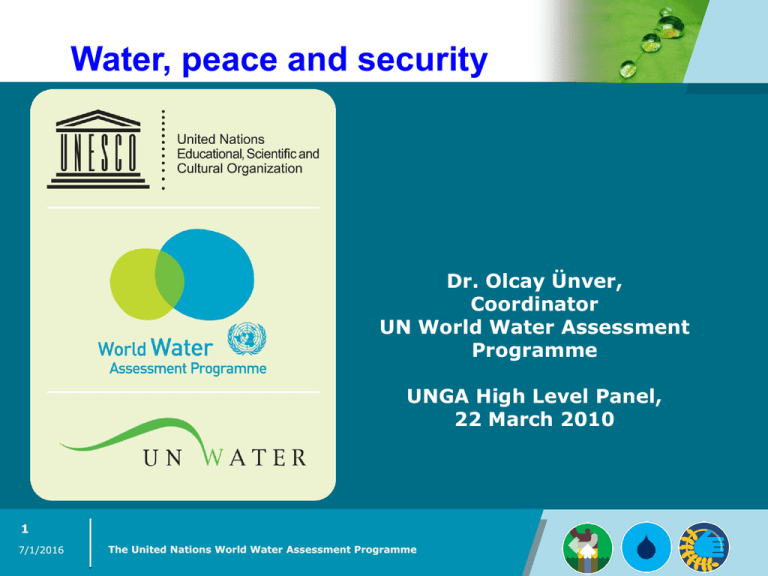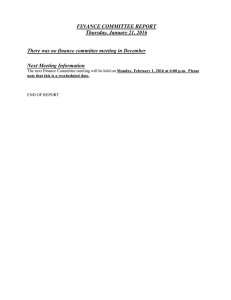
Water, peace and security
Dr. Olcay Ünver,
Coordinator
UN World Water Assessment
Programme
UNGA High Level Panel,
22 March 2010
1
7/1/2016
The United Nations World Water Assessment Programme
Five Messages:
1.Water issues are immediate and urgent.
2.Water and security are linked both directly
and via food, energy, health and
environment.
3.Policies and action to tackle climate change,
economic crisis and other development
issues MUST include water explicitly.
4.There are tools and examples that can help.
5.What we don’t know can really hurt us.
2
7/1/2016
The United Nations World Water Assessment Programme
Five Messages:
1.Water issues are immediate and urgent.
2.Water and security are linked both directly
and via food, energy, health and
environment.
3.Policies and action to tackle climate change,
economic crisis and other development
issues MUST include water explicitly.
4.There are tools and examples that can help.
5.What we don’t know can really hurt us.
3
7/1/2016
The United Nations World Water Assessment Programme
Assessing Water Resources
“water - a finite resource - will become a major
limiting factor in socio-economic development unless
early action is taken. The seriousness of the situation
calls for the highest priority to be given to the
freshwater problems facing many regions, especially
in the developing world.”
19th Special Session of the UN General
Assembly (UNGASS), 1997
4
7/1/2016
The United Nations World Water Assessment Programme
The World Water Assessment
Programme
In 1998, the Commission on Sustainable Development called for
UN agencies to combine their efforts in order to produce a
periodic report on the status of the world’s freshwater
resources.
In March 2000, the Director-General of UNESCO announced the
launching of WWAP at the 2nd World Water Forum in The
Hague.
WWAP is the UN System’s reporting mechanism to monitor progress
towards internationally agreed-upon goals about water.
5
7/1/2016
The United Nations World Water Assessment Programme
ONE-UN: UN-Water
World Water Assessment Programme, 2009, UN World Water Development Report 3:
Water in a Changing World; Paris, UNESCO and London, Earthscan, p. v
© UNESCO 2006. All rights reserved.
6
7/1/2016
The United Nations World Water Assessment Programme
UN System’s response: UN-Water
Collective product of UN-Water’s 27 agencies, the United
Nations World Water Development Report (WWDR), is a
periodic, comprehensive review providing an authoritative
picture of the state of the world’s freshwater resources.
The fourth
report (WWDR4)
is to be launched
in Marseille,
2012
1st report
(WWDR1)
2000, Kyoto
2nd report
(WWDR2)
2006, Mexico City
7
7/1/2016
7/1/2016
The United Nations World Water Assessment Programme
3rd report
(WWDR3)
2009, Istanbul
Five Messages:
1.Water issues are immediate and urgent.
2.Water and security are linked both directly
and via food, energy, health and
environment.
3.Policies and action to tackle climate change,
economic crisis and other development
issues MUST include water explicitly.
4.There are tools and examples that can help.
5.What we don’t know can really hurt us.
8
7/1/2016
The United Nations World Water Assessment Programme
WATER STRESS
Water use increased at more than twice the rate of population
growth during the 20th century.
85% of the world’s people live in the drier half of the planet.
More than 1 billion people living in arid and semi-arid parts of
the world have little or no access to renewable water
resources.
Currently, an estimated 26 countries with a
combined population of more than 350 million
people are located in regions with severe water
scarcity where the available water resources
seem to be sufficient to meet reasonable
water needs for development activities.
9
7/1/2016
The United Nations World Water Assessment Programme
Increasing Water Scarcity
World Water Assessment Programme, 2009. UN World Water Development Report 3: Water in a Changing World.
Paris, UNESCO and London, Earthscan, Map 8.1.
10
7/1/2016
The United Nations World Water Assessment Programme
The Transboundary Context
The number of transboundary basins increased from 214 in
1978 to 276 in 2008.
11
7/1/2016
The United Nations World Water Assessment Programme
Water is embedded in food and products
• Trade of virtual water accounts for 15% of
all water used globally.
• Indicates that scarcity, pollution etc can
also be exported.
• Used properly in decisions, can provide for
better resource allocation.
• Also a political tool to convert narrow
security concerns into broader security
notions (e.g. from food self sufficiency to
general food security)
12
7/1/2016
The United Nations World Water Assessment Programme
Virtual water flow via trade
13
7/1/2016
The United Nations World Water Assessment Programme
Five Messages:
1.Water issues are immediate and urgent.
2.Water and security are linked both directly
and via food, energy, health and
environment.
3.Policies and action to tackle climate change,
economic crisis and other development
issues MUST include water explicitly.
4.There are tools and examples that can help.
5.What we don’t know can really hurt us.
14
7/1/2016
The United Nations World Water Assessment Programme
Water is impacted by
•
•
•
•
•
•
•
Environmental security policies
Food policies
Energy policies
Demographics
Climate change adaptation
Land use policies
International trade, subsidies and incentives
– Among others
15
7/1/2016
The United Nations World Water Assessment Programme
Example: Climate change
Water is the principal medium through which climate change will
affect economic, social and environmental conditions.
Changes in water availability will have economy-wide impacts.
The UNFCC* estimates the additional investment required for adaptation to
climate change will average $28-$67 billion a year over the coming
decades, reaching as high as $100 billion several decades from now. The
additional investment in water supply infrastructure that will be required by
2030 is estimated at $11 billion, 85% of this in developing countries. This is
to be complemented by infrastructure for productive uses of water as well
as to deal with its extremes.
*The United Nations Framework Convention on Climate Change
16
7/1/2016
The United Nations World Water Assessment Programme
Five Messages:
1.Water issues are immediate and urgent.
2.Water and security are linked both directly
and via food, energy, health and
environment.
3.Policies and action to tackle climate change,
economic crisis and other development
issues MUST include water explicitly.
4.There are tools and examples that can help.
5.What we don’t know can really hurt us.
17
7/1/2016
The United Nations World Water Assessment Programme
Defining a Common Interest
Improving water efficiency,
New technology
Implementing integrated water resources management,
Strengthening institutions
Capacity-building
Sharing the benefits
Virtual Water
18
7/1/2016
The United Nations World Water Assessment Programme
Defining a Common Interest
Cooperation rather than conflict is the norm for transboundary issues
19
7/1/2016
-7 Formal War,
1 Minor official exchanges, talks or policy expressions,
The United Nations World Water Assessment Programme
6 International Freshwater Treaty; Major strategic alliance
The Dynamics of Cooperation
Coordination: Sharing of information, communication, assessments
Cooperation: Joint projects, active planning, adaptation of national plans to factor
in regional costs and benefits
Collaboration: Formalized agreements, Integrated Basin Management, joint
institutions
20
7/1/2016
The United Nations World Water Assessment Programme
Five Messages:
1.Water issues are immediate and urgent.
2.Water and security are linked both directly
and via food, energy, health and
environment.
3.Policies and action to tackle climate change,
economic crisis and other development
issues MUST include water explicitly.
4.There are tools and examples that can help.
5.What we don’t know can really hurt us.
21
7/1/2016
The United Nations World Water Assessment Programme
We don’t know enough
•
•
•
•
Quantity, quality and distribution of the resource
How agriculture, cities and industries use it
How it is managed
How much is invested
“… the world's network of rainfall and stream gages – often a low priority
in science budgets – is slowly eroding. That decline means that at a time
when global warming may be exacerbating weather extremes and water
shortages, scientists are less able to monitor water supplies, predict
droughts, and forecast floods than they were 30 years ago”.
(Science Magazine, August 20, 1999, 285:5431, pp.
1199 – 1200)
22
7/1/2016
The United Nations World Water Assessment Programme
Our information base has been shrinking
Only dark blue dots signify actual data collection
World Water Assessment Programme, 2009. UN World Water Development Report 3: Water in a Changing World.
Paris, UNESCO and London, Earthscan, Map 13.1.
23
7/1/2016
The United Nations World Water Assessment Programme
Concluding points:
Water has remained too low on the list of political priorities for too long.
Neglecting the need for investments has caused development to lag,
people to suffer and the environment to deteriorate.
The resources needed to address the problems of water management
are minuscule compared with the financial resources that have been
pledged and secured to deal with carbon emissions or the recent
financial crisis.
As climate change evolves, governments will have to learn to operate
under conditions of greater risk and uncertainty.
Sharing information is key for better sharing of resources/benefits.
More investment in data is essential, as well as in scenario tools that
inform decision-making.
Inaction is not an option.
24
7/1/2016
The United Nations World Water Assessment Programme
For more information on the World
Water Assessment Programme
and its activities,
or to download our publications
please visit:
http://www.unesco.org/water /wwap
Thank you!
25
7/1/2016
The United Nations World Water Assessment Programme

